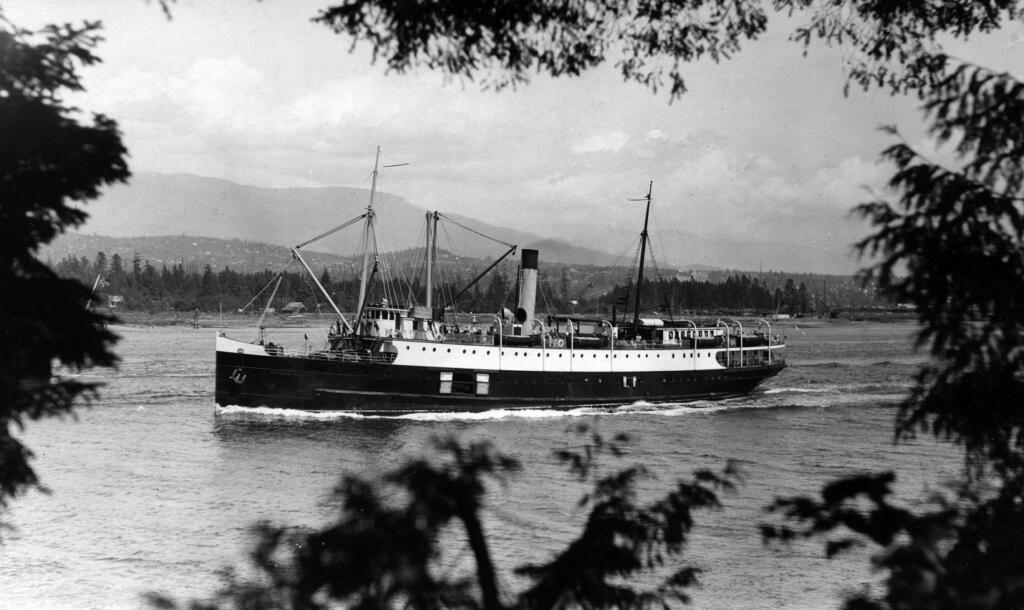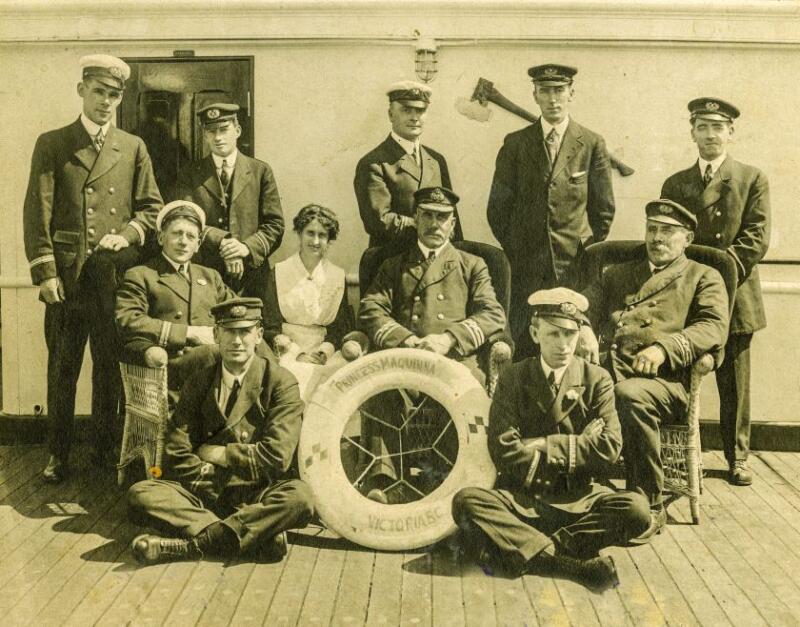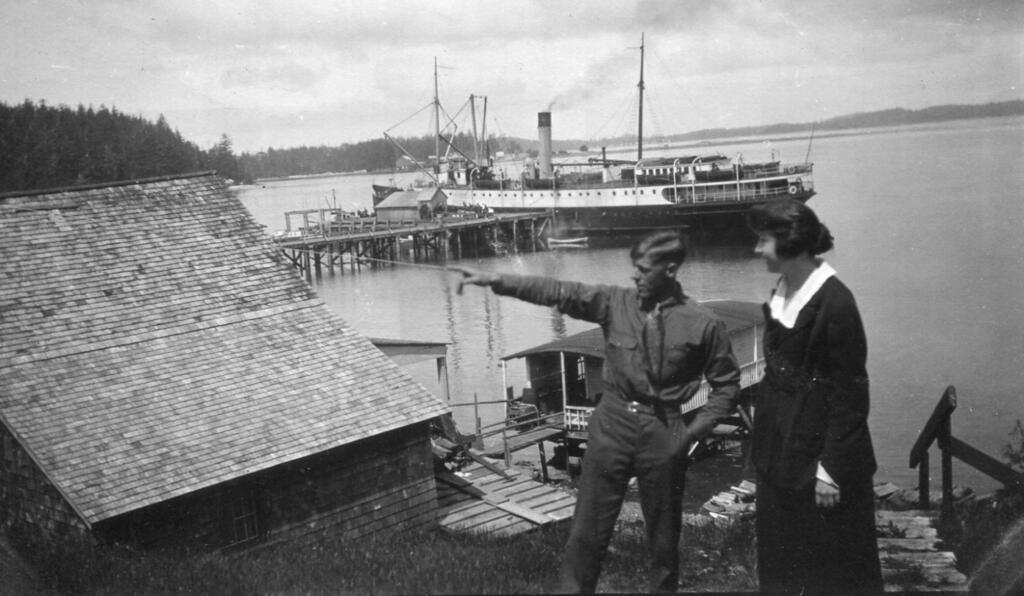Stepping aboard the Maquinna
The Best Loved Boat: The Princess Maquinna
by Ian Kennedy
Madeira Park: Harbour Publishing, 2023
$34.95 / 9781990776403
Reviewed by Trevor Marc Hughes
*

Ian Kennedy asks his readers to imagine another time, when passengers would step aboard ‘Old Faithful,’ the ‘Good Ship’ SS Princess Maquinna and cruise up the west coast of Vancouver Island on a week-long cruise. Operated by the Canadian Pacific Steamship Company, ‘part of the global Canadian Pacific Railway empire.’ An inviting CPR poster featuring colourful artwork on the cover, and a detailed map of Vancouver Island from a CPR tourist brochure indicating the route and stops of the dedicated steamship help to whet the appetite of the reader that they are about to go back to 1924 to enjoy an adventure in an age gone by of dedicated steamships.

Beginning its service in 1913, the Maquinna would depart from Victoria at 11PM, three times a month. This was no cruise. She was a working vessel, stopping in at various communities including Bamfield, Ahousaht, and Quatsino Sound, but also working environments such as Cachalot whaling station. Ian Kennedy gifts us with a detailed and well-researched look into an era of steamship travel on the British Columbia coast. Boarding the Maquinna in Victoria, at the newly-built Canadian Pacific Steamship terminal at the Inner Harbour, we are witness to a boarding procedure that is quite different to that we’d experience boarding a BC Ferries vessel today: meeting ship’s personnel, mingling with fellow passengers, watching the loading of goods and supplies destined for loggers and communities at the various stops ahead. It was “akin to boarding a local bus.” Kennedy also points out aspects of boarding a steamship a century ago which may not meet the approval of readers today, such as First Nations and Asian passengers being segregated to the outside deck forward. But these, as in all historical tales, are to be taken with the tenor of the times. After all, why read about history if it meets the standards of today? Kennedy does highlight how Indigenous and Chinese workers were an integral part of mills up and down the coast, including in fish-processing, a vital part of British Columbia’s economy at the time.

It is this step back in time, and illustrating of differences in how things were carried out, that makes for such fascinating reading. Kennedy not only describes the practices on board a steamship of the times, he also takes the opportunity to use the various stops along the voyage to illustrate the people and happenings of those days, placing us into historical context in a British Columbia of the past.
In the Maquinna’s thirty-nine years of service, all would not go according to plan. She would strike rocks, collide with other vessels, and endure rough open seas during winter voyages. The vessel managed to survive “The Graveyard of the Pacific,” a notorious stretch of water between Port Renfrew and Bamfield that had claimed many ships, including, most notoriously, the SS Valencia, with the loss of one hundred and thirty-six souls.

The ship had an excellent captain. Edward Gillam knew the waters so well, and would sometimes have to contend with fog and other meteorological hazards to navigation. Kennedy discusses the methods of how Gillam would manage in precarious conditions.
Like a blind person with a cane, the whole secret of making way in fog depended on sound. Steam engines like the Princess Maquinna’s made far less noise than modern diesel engines, giving captains a far greater ability to hear what they needed to hear. They knew exactly how to listen, with a watch in their hands. Knowing sound travels at the rate of 1,126 ft (343 m) per second or about 5.5 seconds per mile (3 seconds per km), they would sound the ship’s whistle and wait for an echo.
These sorts of differences in modus operandi of the days of steamship travel are historical gems to behold, especially considering the GPS-driven, Google-Street-View world we find ourselves in today.
What also distinguishes that age from our current times, is how the ship itself was manufactured, intended to be the ship of the people. Built in Esquimalt, “the largest such ship every built in BC to that time” in December 1912, the ship and its construction generated great anticipation.
All up and down the west coast of Vancouver Island, local people who had long waited for their new steamer followed every detail of the shipbuilding progress with keen interest. This would be their ship, and she was being built especially to serve them. They began making preparations to welcome their new vessel.
A distinguishing fact of the vessel, is that she was named for a First Nations princess, in sharp contrast to the other CPR steamships of the time who “had been named for European princesses.” This was an acknowledgment of its time. The loved steamship, plying the waters leading to Nootka Sound, would feature the name of the daughter of Chief Maquinna, an important figure when Captain George Vancouver was in those waters. Kennedy’s description of how the steamship was so named is not only fascinating, it points out how, even then, acknowledging First Nations and their earlier presence on these lands was being introduced to settler infrastructure.
Featuring an excellent collection of archival photography, brochures, posters to place the reader in the times, The Best Loved Boat is a fine recollection, an assembly of places and personages that truly make up the history of this province, and it’s the beloved SS Princess Maquinna that takes us there.

*

Trevor Marc Hughes has written several books and many articles about his motorcycle travels across British Columbia. He edited Riding the Continent, Hamilton Mack Laing’s account of his 1915 ride on a Harley-Davidson 11-F across the continental United States. He’s the author of Capturing the Summit: Hamilton Mack Laing and the Mount Logan Expedition of 1925. He is currently the interim non-fiction editor for The British Columbia Review and recently reviewed books by John Vaillant, Peter Rowlands, and Daniel Arnold, Darrell Dennis, & Medina Hahn.
[Editor’s Note: Ian Kennedy is interviewed for the British Columbia Interview Series here]
*
The British Columbia Review
Interim Editors, 2023-24: Trevor Marc Hughes (non-fiction), Brett Josef Grubisic (fiction)
Publisher: Richard Mackie
Formerly The Ormsby Review, The British Columbia Review is an on-line book review and journal service for BC writers and readers. The Advisory Board now consists of Jean Barman, Wade Davis, Robin Fisher, Barry Gough, Hugh Johnston, Kathy Mezei, Patricia Roy, Maria Tippett, and Graeme Wynn. Provincial Government Patron (since September 2018): Creative BC. Honorary Patron: Yosef Wosk. Scholarly Patron: SFU Graduate Liberal Studies. The British Columbia Review was founded in 2016 by Richard Mackie and Alan Twigg.
“Only connect.” – E.M. Forster































4 comments on “Stepping aboard the Maquinna”